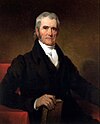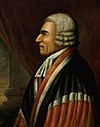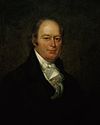List of United States Supreme Court cases, volume 5
| Supreme Court of the United States | |
|---|---|
 | |
| Established | March 4, 1789[1] |
| Location | Washington, D.C. |
| Coordinates | 38°53′26″N 77°00′16″W / 38.89056°N 77.00444°WCoordinates: 38°53′26″N 77°00′16″W / 38.89056°N 77.00444°W |
| Composition method | Presidential nomination with Senate confirmation |
| Authorized by | Constitution of the United States, Art. III, § 1 |
| Judge term length | life tenure, subject to impeachment and removal |
| Number of positions | 9 (by statute) |
| Website | supremecourt |
| Chief Justice of the United States | |
| Currently | John Roberts |
| Since | September 29, 2005 |
| This article is part of the series on the |
| Supreme Court of the United States |
|---|
 |
| The Court |
|
| Current membership |
|
| Lists of justices |
|
| Court functionaries |
|
|
| Constitutional law of the United States |
|---|
 |
| Overview |
|
| Principles |
|
| Government structure |
|
| Individual rights |
|
| Theory |
|
This is a list of the 24 cases reported in volume 5 (1 Cranch) of United States Reports, decided by the Supreme Court of the United States from August 1801 to March 1803.[2]
Nominative reports[]
In 1874, the U.S. government created the United States Reports, and retroactively numbered older privately-published case reports as part of the new series. As a result, cases appearing in volumes 1–90 of U.S. Reports have dual citation forms; one for the volume number of U.S. Reports, and one for the volume number of the reports named for the relevant reporter of decisions (these are called "nominative reports").
William Cranch[]
Starting with the 5th volume of U.S. Reports, the Reporter of Decisions of the Supreme Court of the United States was William Cranch. Cranch was Reporter of Decisions from 1801 to 1815, covering volumes 5 through 13 of United States Reports which correspond to volumes 1 through 9 of his Cranch's Reports. As such, the complete citation to, for example, Talbot v. Seeman is 5 U.S. (1 Cranch) 1 (1801).
Justices of the Supreme Court at the time of 5 U.S. (1 Cranch)[]
The Supreme Court is established by Article III, Section 1 of the Constitution of the United States, which says: "The judicial Power of the United States, shall be vested in one supreme Court . . .". The size of the Court is not specified; the Constitution leaves it to Congress to set the number of justices. Under the Judiciary Act of 1789 Congress originally fixed the number of justices at six (one chief justice and five associate justices).[3] Since 1789 Congress has varied the size of the Court from six to seven, nine, ten, and back to nine justices (always including one chief justice).
John Marshall became Chief Justice in 1801, remaining in that office until his death in 1835; Marshall is the most influential Chief Justice in the Court's history. When the cases in 5 U.S. (1 Cranch) were decided, the Court comprised these six justices:
| Portrait | Justice | Office | Home State | Succeeded | Date confirmed by the Senate (Vote) |
Tenure on Supreme Court |
|---|---|---|---|---|---|---|

|
John Marshall | Chief Justice | Virginia | Oliver Ellsworth | January 27, 1801 (Acclamation) |
February 4, 1801 – July 6, 1835 (Died) |

|
William Cushing |
Associate Justice | Massachusetts | original seat established | September 26, 1789 (Acclamation) |
February 2, 1790 – September 13, 1810 (Died) |

|
William Paterson |
Associate Justice | New Jersey | Thomas Johnson | March 4, 1793 (Acclamation) |
March 11, 1793 – September 8, 1806 (Died) |

|
Samuel Chase |
Associate Justice | Maryland | John Blair, Jr. | January 27, 1796 (Acclamation) |
February 4, 1796 – June 19, 1811 (Died) |

|
Bushrod Washington |
Associate Justice | Virginia | James Wilson | December 20, 1798 (Acclamation) |
November 9, 1798 (Recess Appointment) – November 26, 1829 (Died) |

|
William Johnson |
Associate Justice | South Carolina | Alfred Moore | March 24, 1804 (Acclamation) |
May 7, 1804 – August 4, 1834 (Died) |
Notable cases in 5 U.S. (1 Cranch)[]

Marbury v. Madison[]
Marbury v. Madison, 5 U.S. (1 Cranch) 137 (1803), is a landmark U.S. Supreme Court case that established the principle of judicial review in the United States, meaning that American courts have the power to strike down laws, statutes, and some government actions that they find to violate the Constitution of the United States. Decided in 1803, Marbury remains the single most important decision in American constitutional law. The Court's landmark decision established that the U.S. Constitution is actual law, not just a statement of political principles and ideals, and helped define the boundary between the constitutionally separate executive and judicial branches of the federal government.
Stuart v. Laird[]
Stuart v. Laird, 5 U.S. (1 Cranch) 299 (1803), is a case decided by the Supreme Court a week after its famous decision in Marbury v. Madison. Stuart dealt with a judgment of a circuit judge whose position had been abolished by the repeal of the Judiciary Act of 1801. Stuart's lawyer was Charles Lee, who also represented William Marbury. John Laird asked the Supreme Court to uphold the judge's ruling. Stuart's team argued that only the court rendering a judgment could enforce it and that the 1802 of the Judiciary Act had been unconstitutional, to which Stuart lost on both accounts. The Court reviewed and upheld the constitutionality of the Judiciary Act of 1802 and averted a dangerous showdown between the legislative and the judicial branches of the United States government.
Citation style[]
Under the Judiciary Act of 1789 the federal court structure at the time comprised District Courts, which had general trial jurisdiction; Circuit Courts, which had mixed trial and appellate (from the US District Courts) jurisdiction; and the United States Supreme Court, which had appellate jurisdiction over the federal District and Circuit courts—and for certain issues over state courts. The Supreme Court also had limited original jurisdiction (i.e., in which cases could be filed directly with the Supreme Court without first having been heard by a lower federal or state court). There were one or more federal District Courts and/or Circuit Courts in each state, territory, or other geographical region.
Bluebook citation style is used for case names, citations, and jurisdictions.
- "C.C.D." = United States Circuit Court for the District of . . .
- e.g.,"C.C.D.N.J." = United States Circuit Court for the District of New Jersey
- "D." = United States District Court for the District of . . .
- e.g.,"D. Mass." = United States District Court for the District of Massachusetts
- "E." = Eastern; "M." = Middle; "N." = Northern; "S." = Southern; "W." = Western
- e.g.,"C.C.S.D.N.Y." = United States Circuit Court for the Southern District of New York
- e.g.,"M.D. Ala." = United States District Court for the Middle District of Alabama
- "Adm." = Admiralty Court (a federal court)
- "Ct. Cl." = United States Court of Claims
- "Ct. Com. Pl." = Court of Common Pleas (a state court)
- The abbreviation of a state's name alone indicates the highest appellate court in that state's judiciary at the time.
- e.g.,"Pa." = Supreme Court of Pennsylvania
- e.g.,"Me." = Supreme Judicial Court of Maine
List of cases in 5 U.S. (1 Cranch)[]
| Case Name | Page & year | Opinion of the Court | Concurring opinion(s) | Dissenting opinion(s) | Lower court | Disposition of case |
|---|---|---|---|---|---|---|
| Talbot v. Seeman | 1 (1801) | Marshall | none | none | C.C.D.N.Y. | affirmed (part); reversed (part) |
| Wilson v. Mason | 45 (1801) | per curiam | none | none | D. Ky. | reversed |
| The Schooner Peggy | 103 (1801) | Marshall | none | none | C.C.D. Conn. | reversed |
| Resler v. Shehee | 110 (1801) | per curiam | none | none | C.C.D.C. | affirmed |
| Turner v. Fendall | 116 (1801) | Marshall | none | none | C.C.D.C. | affirmed |
| Marbury v. Madison | 137 (1803) | Marshall | none | none | original jurisdiction | rule discharged |
| Clark v. Young | 181 (1803) | Marshall | none | none | C.C.D.C. | affirmed |
| Wilson v. Lenox | 194 (1803) | Marshall | none | none | C.C.D.C. | reversed |
| Clarke v. Bazadone | 212 (1803) | per curiam | none | none | Gen. Ct. N.W. Terr. | writ of error quashed |
| Hooe & Co. v. Groverman | 214 (1803) | Marshall | none | none | C.C.D.C. | reversed |
| Wood v. Owings | 239 (1803) | Marshall | none | none | C.C.D. Md. | reversed |
| United States v. Simms | 252 (1803) | Marshall | none | none | C.C.D.C. | affirmed |
| Fenwick v. Sears's Adm'rs | 259 (1803) | per curiam | none | none | C.C.D.C. | reversed |
| Thompson v. Jameson | 282 (1803) | per curiam | none | none | C.C.D.C. | reversed |
| Mandeville v. Joseph Riddle & Co. | 290 (1803) | Marshall | none | none | C.C.D.C. | reversed |
| Stuart v. Laird | 299 (1803) | Paterson | none | none | C.C.D. Va. | affirmed |
| Hamilton v. Russell | 309 (1803) | Marshall | none | none | C.C.D.C. | affirmed |
| United States v. Hooe | 318 (1803) | per curiam | none | none | C.C.D.C. | remanded to divided lower court |
| Hepburn v. Auld | 321 (1803) | Marshall | none | none | C.C.D.C. | affirmed |
| Marine Ins. Co. v. Young | 332 (1803) | per curiam | none | none | not indicated | not indicated |
| Abercrombie v. Dupuis | 343 (1803) | Marshall | none | none | C.C.D. Ga. | reversed |
| Lindo v. Gardner | 343 (1803) | per curiam | none | none | C.C.D.C. | reversed |
| Hodgson v. Dexter | 345 (1803) | Marshall | none | none | C.C.D.C. | affirmed |
| Lloyd v. Alexander | 365 (1803) | Marshall | none | none | not indicated | remanded to divided lower court |
Notes and references[]
- ^ Lawson, Gary; Seidman, Guy (2001). "When Did the Constitution Become Law?". Notre Dame Law Review. 77: 1–37.
- ^ Anne Ashmore, DATES OF SUPREME COURT DECISIONS AND ARGUMENTS, Library, Supreme Court of the United States, 26 December 2018.
- ^ "Supreme Court Research Guide". Georgetown Law Library. Retrieved April 7, 2021.
See also[]
- certificate of division
External links[]
- [1] Case reports in volume 5 (1 Cranch) from Court Listener
- [2] Case reports in volume 5 (1 Cranch) from the Caselaw Access Project of Harvard Law School
- [3] Case reports in volume 5 (1 Cranch) of Justia
- [4] Case reports in volume 5 (1 Cranch) from Open Jurist
- Website of the United States Supreme Court
- United States Courts website about the Supreme Court
- National Archives, Records of the Supreme Court of the United States
- American Bar Association, How Does the Supreme Court Work?
- The Supreme Court Historical Society
| Wikisource has original text related to this article: |
- Lists of United States Supreme Court cases by volume
- Lists of United States Supreme Court cases
- United States Supreme Court cases
- United States case law lists
- 1801 in United States case law
- 1803 in United States case law

